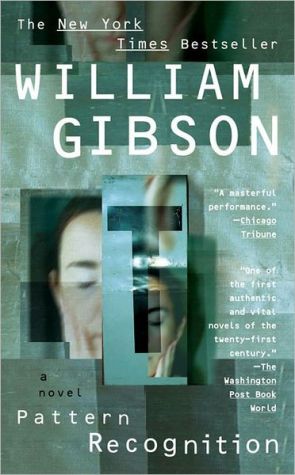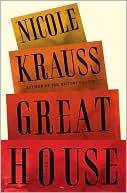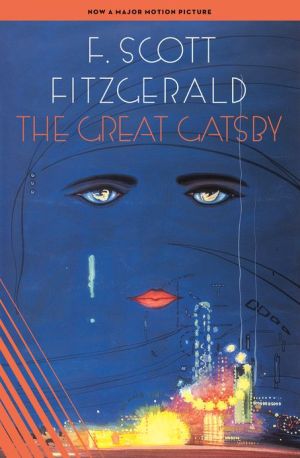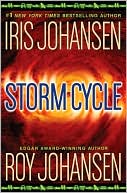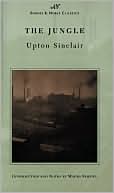Pattern Recognition
Cayce Pollard is an expensive, spookily intuitive market-research consultant. In London on a job, she is offered a secret assignment: to investigate some intriguing snippets of video that have been appearing on the Internet. An entire subculture of people is obsessed with these bits of footage, and anybody who can create that kind of brand loyalty would be a gold mine for Cayce's client. But when her borrowed apartment is burgled and her computer hacked, she realizes there's more to this...
Search in google:
Cayce Pollard is a new kind of prophet - a world renowned "coolhunter" who predicts the hottest trends. While in London to evaluate the redesign of a famous corporate logo, she's offered a different assignment: find the creator of the obscure, enigmatic video clips being uploaded on the Internet - footage that is generating massive underground buzz worldwide.The New YorkerAlmost two decades ago, Gibson's début novel, "Neuromancer," which coined the term "cyberspace," established him as the oracle of postmodern science fiction. His new book, though, is set entirely in the present -- specifically, in the aftermath of September 11th. Cayce Pollard is a brand consultant whose father disappeared on September 11th. She becomes fascinated by mysterious scraps of film footage -- seemingly random scenes, luminously shot -- that are disseminated on the Web and have spawned cults of viewers. Gibson wisely avoids addressing the import of 9/11 head on, but he somehow establishes a powerful correlative for it in Cayce's strange quest -- through the Tokyo red-light district and the Moscow underworld -- to find the anonymous filmmaker. In Gibson's eerie vision of our time, the future has come crashing upon us, fragmentary and undecipherable; as one character declares, "We have no future because our present is too volatile."
THE WEBSITE OF DREADFUL NIGHT\ Five hours' New York jet lag and Cayce Pollard wakes in Camden Town to the dire and ever-circling wolves of disrupted circadian rhythm.\ It is that flat and spectral non-hour, awash in limbic tides, brainstem stirring fitfully, flashing inappropriate reptilian demands for sex, food, sedation, all of the above, and none really an option now.\ Not even food, as Damien's new kitchen is as devoid of edible content as its designers' display windows in Camden High Street. Very handsome, the upper cabinets faced in canary-yellow laminate, the lower with lacquered, unstained apple-ply. Very clean and almost entirely empty, save for a carton containing two dry pucks of Weetabix and some loose packets of herbal tea. Nothing at all in the German fridge, so new that its interior smells only of cold and long-chain monomers.\ She knows, now, absolutely, hearing the white noise that is London, that Damien's theory of jet lag is correct: that her mortal soul is leagues behind her, being reeled in on some ghostly umbilical down the vanished wake of the plane that brought her here, hundreds of thousands of feet above the Atlantic. Souls can't move that quickly, and are left behind, and must be awaited, upon arrival, like lost luggage.\ She wonders if this gets gradually worse with age: the nameless hour deeper, more null, its affect at once stranger and less interesting?\ Numb here in the semi-dark, in Damien's bedroom, beneath a silvery thing the color of oven mitts, probably never intended by its makers to actually be slept under. She'd been too tired to find a blanket. The sheets between her skin and the weight of this industrial coverlet are silky, some luxurious thread count, and they smell faintly of, she guesses, Damien. Not badly, though. Actually it's not unpleasant; any physical linkage to a fellow mammal seems a plus at this point.\ Damien is a friend.\ Their boy-girl Lego doesn't click, he would say.\ Damien is thirty, Cayce two years older, but there is some carefully insulated module of immaturity in him, some shy and stubborn thing that frightened the money people. Both have been very good at what they've done, neither seeming to have the least idea of why.\ Google Damien and you will find a director of music videos and commercials. Google Cayce and you will find "coolhunter," and if you look closely you may see it suggested that she is a "sensitive" of some kind, a dowser in the world of global marketing.\ Though the truth, Damien would say, is closer to allergy, a morbid and sometimes violent reactivity to the semiotics of the marketplace.\ Damien's in Russia now, avoiding renovation and claiming to be shooting a documentary. Whatever faintly lived-in feel the place now has, Cayce knows, is the work of a production assistant.\ She rolls over, abandoning this pointless parody of sleep. Gropes for her clothes. A small boy's black Fruit Of The Loom T-shirt, thoroughly shrunken, a thin gray V-necked pullover purchased by the half-dozen from a supplier to New England prep schools, and a new and oversized pair of black 501's, every trademark carefully removed. Even the buttons on these have been ground flat, featureless, by a puzzled Korean locksmith, in the Village, a week ago.\ The switch on Damien's Italian floor lamp feels alien: a different click, designed to hold back a different voltage, foreign British electricity.\ Standing now, stepping into her jeans, she straightens, shivering.\ Mirror-world. The plugs on appliances are huge, triple-pronged, for a species of current that only powers electric chairs, in America. Cars are reversed, left to right, inside; telephone handsets have a different weight, a different balance; the covers of paperbacks look like Australian money.\ Pupils contracted painfully against sun-bright halogen, she squints into an actual mirror, canted against a gray wall, awaiting hanging, wherein she sees a black-legged, disjointed puppet, sleep-hair poking up like a toilet brush. She grimaces at it, thinking for some reason of a boyfriend who'd insisted on comparing her to Helmut Newton's nude portrait of Jane Birkin.\ In the kitchen she runs tap water through a German filter, into an Italian electric kettle. Fiddles with switches, one on the kettle, one on the plug, one on the socket. Blankly surveys the canary expanse of laminated cabinetry while it boils. Bag of some imported Californian tea substitute in a large white mug. Pouring boiling water.\ In the flat's main room, she finds that Damien's faithful Cube is on, but sleeping, the night-light glow of its static switches pulsing gently. Damien's ambivalence toward design showing here: He won't allow decorators through the door unless they basically agree to not do that which they do, yet he holds on to this Mac for the way you can turn it upside down and remove its innards with a magic little aluminum handle. Like the sex of one of the robot girls in his video, now that she thinks of it.\ She seats herself in his high-backed workstation chair and clicks the transparent mouse. Stutter of infrared on the pale wood of the long trestle table. The browser comes up. She types Fetish:Footage:Forum, which Damien, determined to avoid contamination, will never bookmark.\ The front page opens, familiar as a friend's living room. A frame-grab from #48 serves as backdrop, dim and almost monochrome, no characters in view. This is one of the sequences that generate comparisons with Tarkovsky. She only knows Tarkovsky from stills, really, though she did once fall asleep during a screening of The Stalker, going under on an endless pan, the camera aimed straight down, in close-up, at a puddle on a ruined mosaic floor. But she is not one of those who think that much will be gained by analysis of the maker's imagined influences. The cult of the footage is rife with subcults, claiming every possible influence. Truffaut, Peckinpah . . . The Peckinpah people, among the least likely, are still waiting for the guns to be drawn.\ She enters the forum itself now, automatically scanning titles of the posts and names of posters in the newer threads, looking for friends, enemies, news. One thing is clear, though; no new footage has surfaced. Nothing since that beach pan, and she does not subscribe to the theory that it is Cannes in winter. French footageheads have been unable to match it, in spite of countless hours recording pans across approximately similar scenery.\ She also sees that her friend Parkaboy is back in Chicago, home from an Amtrak vacation, California, but when she opens his post she sees that he's only saying hello, literally.\ She clicks Respond, declares herself CayceP.\ Hi Parkaboy. nt\ When she returns to the forum page, her post is there.\ It is a way now, approximately, of being at home. The forum has become one of the most consistent places in her life, like a familiar café that exists somehow outside of geography and beyond time zones.\ There are perhaps twenty regular posters on F:F:F, and some much larger and uncounted number of lurkers. And right now there are three people in Chat, but there's no way of knowing exactly who until you are in there, and the chat room she finds not so comforting. It's strange even with friends, like sitting in a pitch-dark cellar conversing with people at a distance of about fifteen feet. The hectic speed, and the brevity of the lines in the thread, plus the feeling that everyone is talking at once, at counter-purposes, deter her.\ The Cube sighs softly and makes subliminal sounds with its drive, like a vintage sports car downshifting on a distant freeway. She tries a sip of tea substitute, but it's still too hot. A gray and indeterminate light is starting to suffuse the room in which she sits, revealing such Damieniana as has survived the recent remake.\ Partially disassembled robots are propped against one wall, two of them, torsos and heads, like elfin, decidedly female crash-test dummies. These are effects units from one of Damien's videos, and she wonders, given her mood, why she finds them so comforting. Probably because they are genuinely beautiful, she decides. Optimistic expressions of the feminine. No sci-fi kitsch for Damien. Dreamlike things in the dawn half-light, their small breasts gleaming, white plastic shining faint as old marble. Personally fetishistic, though; she knows he'd had them molded from a body cast of his last girlfriend, minus two.\ Hotmail downloads four messages, none of which she feels like opening. Her mother, three spam. The penis enlarger is still after her, twice, and Increase Your Breast Size Dramatically.\ Deletes spam. Sips the tea substitute. Watches the gray light becoming more like day.\ Eventually she goes into Damien's newly renovated bathroom. Feels she could shower down in it prior to visiting a sterile NASA probe, or step out of some Chernobyl scenario to have her lead suit removed by rubber-gowned Soviet technicians, who'd then scrub her with long-handled brushes. The fixtures in the shower can be adjusted with elbows, preserving the sterility of scrubbed hands.\ She pulls off her sweater and T-shirt and, using hands, not elbows, starts the shower and adjusts the temperature.\ FOUR hours later she's on a reformer in a Pilates studio in an upscale alley called Neal's Yard, the car and driver from Blue Ant waiting out on whatever street it is. The reformer is a very long, very low, vaguely ominous and Weimar-looking piece of spring-loaded furniture. On which she now reclines, doing v-position against the foot rail at the end. The padded platform she rests on wheels back and forth along tracks of angle-iron within the frame, springs twanging softly. Ten of these, ten toes, ten from the heels. . . In New York she does this at a fitness center frequented by dance professionals, but here in Neal's Yard, this morning, she seems to be the sole client. The place is only recently opened, apparently, and perhaps this sort of thing is not yet so popular here. There is that mirror-world ingestion of archaic substances, she thinks: People smoke, and drink as though it were good for you, and seem to still be in some sort of honeymoon phase with cocaine. Heroin, she's read, is cheaper here than it's ever been, the market still glutted by the initial dumping of Afghani opium supplies.\ Done with her toes, she changes to heels, craning her neck to be certain her feet are correctly aligned. She likes Pilates because it isn't, in the way she thinks of yoga, meditative. You have to keep your eyes open, here, and pay attention.\ That concentration counters the anxiety she feels now, the pre-job jitters she hasn't experienced in a while.\ She's here on Blue Ant's ticket. Relatively tiny in terms of permanent staff, globally distributed, more post-geographic than multinational, the agency has from the beginning billed itself as a high-speed, low-drag life-form in an advertising ecology of lumbering herbivores. Or perhaps as some non-carbon-based life-form, entirely sprung from the smooth and ironic brow of its founder, Hubertus Bigend, a nominal Belgian who looks like Tom Cruise on a diet of virgins' blood and truffled chocolates.\ The only thing Cayce enjoys about Bigend is that he seems to have no sense at all that his name might seem ridiculous to anyone, ever. Otherwise, she would find him even more unbearable than she already does.\ It's entirely personal, though at one remove.\ Still doing heels, she checks her watch, a Korean clone of an old-school Casio G-Shock, its plastic case sanded free of logos with a scrap of Japanese micro-abrasive. She is due in Blue Ant's Soho offices in fifty minutes.\ She drapes a pair of limp green foam pads over the foot rail, carefully positions her feet, lifts them on invisible stiletto heels, and begins her ten prehensile.\ —Reprinted from Pattern Recognition by William Gibson by permission of G. P. Putnam’s Sons, a member of Penguin Putnam Inc. Copyright © 2003, William Gibson. All rights reserved. This excerpt, or any parts thereof, may not be reproduced in any form without permission.\ \
\ From Barnes & NobleThe Barnes & Noble Review\ In the first sentence of his first novel, William Gibson penned one of the most memorable lines in the last quarter century of science fiction or, indeed, any literature: “The sky above the port was the color of television, tuned to a dead channel.” Gibson invented cyberspace, envisioned the “matrix.” Imagine what he could do with the present. \ Well, imagine no more. Pattern Recognition is a wild ride through a world of Hotmail accounts, Tommy Hilfiger displays, Pilates studios: our world. Your protagonist: Cayce Pollard, whose talent consists of a truly extraordinary allergy to brands, trademarks, and fashion. Which, inevitably, makes her invaluable to marketers everywhere on earth.\ But this assignment…this one doesn’t merely involve reacting to a logo design. This one is a sprawling mystery. Where do those odd video posts to the Internet come from? Why do they inspire such fanatic loyalty? And who is it that really wants to know -- enough to break into Cayce's apartment, hack her computer, threaten her life?\ Walk away? Cayce Pollard has her father’s stubbornness: a former intelligence agent, he was last seen in a taxi headed toward the World Trade Center on September 11, 2001...\ This is a story we couldn’t stop reading and can’t forget. Bill Camarda\ Bill Camarda is a consultant, writer, and web/multimedia content developer. His 15 books include Special Edition Using Word 2000 and Upgrading & Fixing Networks For Dummies®, Second Edition.\ \ \ \ \ \ The Village VoicePattern recognition, Gibson makes clear, is not just the coolhunter's job description but a survival tactic within the context of no context -- dowsing for meaning, and sometimes settling for the illusion of meaning, as our accelerating now leaves us ever further behind.\ \ \ Chicago TribuneIt turns out that William Gibson knows as much about the present as he does about the future....Now, in his first book set in the preset, Gibson turns loose the full power of his laser eyes and his non-judgmental but awesomely encompassing heart on an exciting thriller that is basically a modern fable, a quest for hints on how to live now....It's a masterful performance from a major novelist who seems to be just now hitting his peak. Welcome to the present, Mr. Gibson\ \ \ \ \ Washington Post..overall, Gibson has delivered what is assuredly one of the first authentic and vital novels of the 21st century, placing himself alongside Haruki Murakami as a writer who can conjure the numinous out of the quotidian.\ \ \ \ \ San Francisco Chronicle...The completely contemporary "Pattern Recognition" finds the author rejuvenated, ready to acknowledge that the world has become a stranger place than could have been imagined even 15 years ago. It's his best book in a long time, and perhaps his most accessible one ever!\ \ \ \ \ The New YorkerAlmost two decades ago, Gibson's début novel, "Neuromancer," which coined the term "cyberspace," established him as the oracle of postmodern science fiction. His new book, though, is set entirely in the present -- specifically, in the aftermath of September 11th. Cayce Pollard is a brand consultant whose father disappeared on September 11th. She becomes fascinated by mysterious scraps of film footage -- seemingly random scenes, luminously shot -- that are disseminated on the Web and have spawned cults of viewers. Gibson wisely avoids addressing the import of 9/11 head on, but he somehow establishes a powerful correlative for it in Cayce's strange quest -- through the Tokyo red-light district and the Moscow underworld -- to find the anonymous filmmaker. In Gibson's eerie vision of our time, the future has come crashing upon us, fragmentary and undecipherable; as one character declares, "We have no future because our present is too volatile."\ \ \ \ \ Publishers WeeklyGibson, known as the "patron saint of cyberpunk lit," has made his reputation with futuristic tales. Though his new novel is set in the present, baroque descriptions of everyday articles and menacing anthropomorphic treatment of the Internet and sister technology give it a sci-fi feel. Cayce Pollard, a market researcher with razor-sharp intuition, makes big bucks by evaluating potential products and advertising campaigns. In London, she stays in the trendy digs of documentary filmmaker friend Damien (away on assignment), whom she e-mails frequently. When Cayce brusquely rejects the new logo of advertising mogul Hubertus Bigend, she earns his respect and a big check but makes an enemy of his graphic designer, vindictive Dorotea Benedetti. Hubertus later hires Cayce to ferret out the origin of a series of sensual film clips appearing guerrilla style on computers all over the world and attracting a growing cult following. Cayce treats this as a standard job until somebody breaks into Damien's flat and hacks into her computer. Suddenly every casual encounter carries undertones of danger. Her investigative trail takes her to Tokyo and Russia and through a rogue's gallery of iconoclastic Web-heads. Casting a further shadow is the memory of her father, Win, a security expert (probably CIA) missing and presumed dead in the World Trade Center disaster of exactly a year earlier. For complicated reasons even she doesn't understand, she connects her current dilemma with her father's tragedy and follows the trail with the fervor of a personal vendetta. Gibson's brisk, kinetic style and incisive observations should keep the reader entertained even when Cayce's quest begins to lose urgency. Gibson's best book since Mona Lisa Overdrive should satisfy his hardcore fans while winning plenty of new ones. Agent, Martha Millard. 10-city author tour; rights sold in Denmark, Germany, Italy, Japan, Russia, Spain and the U.K. (Feb.) Forecast: Given Gibson's reputation with SF fans, his grasp of popular culture and state-of-the-art technology and his inimitable narrative voice, this chase thriller should take off right out of the gate. Copyright 2003 Cahners Business Information.\ \ \ \ \ Library JournalIn an apparent attempt to write one of the first post-9/11 novels, Gibson, best known for his hip cyberpunk fiction set in a dystopic near future, locates this text in contemporary time. The plot concerns Cayce Pollard, a thirtysomething freelance market researcher, who, because of her phobic reaction to certain brand names that somehow allows her to recognize what will become "cool" and thus profitable, is hired to locate the makers of some cryptic video footage anonymously posted on the Internet. This footage, which inexplicably takes on the status of a modern-day Delphic Oracle, has been an obsession of a cohort of web junkies (including Pollard herself), who prattle on about its possible origin, meaning, and significance. For characterization, Gibson relentlessly employs clothes-catalog descriptions, making this novel virtually impossible to distinguish from the trivialized pop culture it purports to critique. The novel itself may be classified as a melodrama of beset geekdom-focusing on post-9/11, angst-ridden, globe-hopping computer nerds and marketing employees who jet from London to Tokyo and elsewhere, all the while keeping in touch via e-mail and cell phone. This book, which may well reveal the emptiness at the core of Gibson's other fiction, will probably thrill his aficionados but, it is hoped, no one else. Given Gibson's immense popularity, however, it is recommended for all libraries.-Roger A. Berger, Everett Community Coll., WA Copyright 2003 Cahners Business Information.\ \ \ \ \ School Library JournalAdult/High School-Cayce Pollard is a well-paid professional marketer. She and her friends-filmmakers, dealers in electronic esoterica, designers, and hackers-live on the cutting edge of a highly technological, "post-geographic" world, where the manipulation of cultural trends can bring great power. When she is employed to discover the source of "the Footage," a mysterious film that has been appearing in bits and pieces on the Web and gathering a worldwide underground following, her survival is at stake. In her search for the auteur, she outwits corporate spies, terrorists, and mobsters in London, Tokyo, Moscow, and New York; struggles with ethical issues; and even delves into the mystery of her father's disappearance on September 11, 2001. Some readers might feel that this novel demands too much of them-the prose is witty, each page challenges with provocative observations, and there are a lot of pieces to the puzzle. But those who enjoyed Gibson's earlier work, or the writing of Neal Stephenson or Bruce Sterling, should relish this headlong race through an unsettling but recognizable world to a surprisingly humane conclusion.-Christine C. Menefee, Fairfax County Public Library, VA Copyright 2003 Reed Business Information.\ \ \ \ \ From The CriticsNew York Times Book Review\ Elegant, entrancing …. Without any metafictional grandstanding, Gibson nails the texture of internet culture: how it feels to be close to someone you know only as a voice in a chat room, or to fret about someone spying on your browser's list of sites visited. ..."Pattern Recognition" is Gibson's most complex, mature gloss on the artist's relationship to our ever more commercialized globe.\ \ \ \ \ Kirkus ReviewsA return to the present makes this SF scribe more prescient than ever. \ It's been a long time since Gibson wowed us with Neuromancer (1984) and the rest of the Sprawl trilogy that changed the then-moribund field of science fiction forever. Unfortunately, it's been a hard act to live up to. His latest might not satisfy his readers' high level of expectation, either, but it's doubtless his best work since Count Zero (1986). Even though it's his first novel set entirely in present time, there's a sense that he's getting back to his roots. The heroine, Cayce, is a nod to the hacker in Neuromancer who became the prototypical cyberpunk antihero. She's a cool, slinky, yet insecure piece of mystery who has a near-oracular ability to predict the Next Big Thing. After being called in to consult on whether a new logo will work, Cayce says only one word, "No," and her fee is earned. She's then hired for a bigger project by über-cool marketing firm Blue Ant to investigate the origins of a strange series of film clips-over a 130 now-that have been showing up on the Internet and attracting a wide cult of fans, including Cayce, who try to figure their origin and purpose. Soon Cayce is jetting off to Tokyo, back to London, then off to Russia, following the wispiest threads of evidence, rumor, and blind conjecture. Someone's tracking her, and a sinister fog of suspicion fills Cayce's jet-setting, wireless world. Gibson's narrative is more relaxed than it has been in years, trusting in Cayce's strangely addictive personality and in his own laser-perfect cultural radar-Malcolm Gladwell meets Marshall McLuhan in a chat room-to carry the story along. Some elements could have easily been jettisoned (Cayce'sliteral allergy to brands and logos is ridiculous), but for every misstep there's a dash of pure, beautiful insight: "We have no future because our present is too volatile . . . We have only risk management. The spinning of the given moment's scenarios. Pattern recognition."\ A slick but surprisingly humane piece of work from the father of cyberpunk.\ \ \
